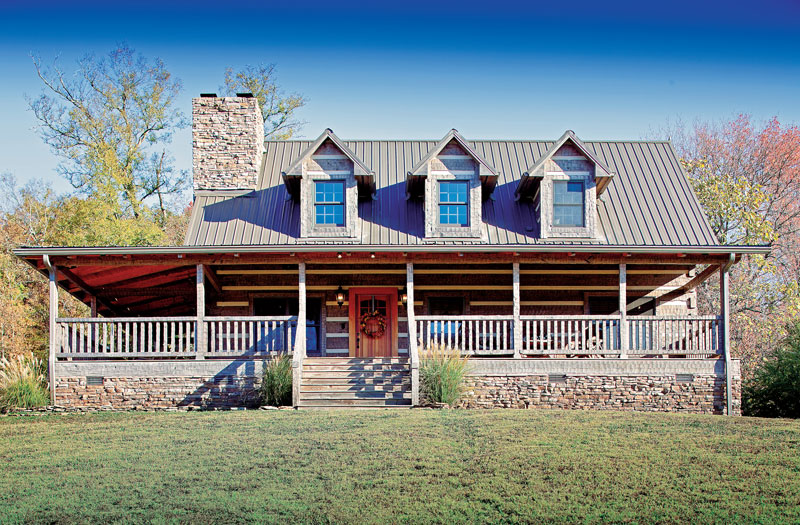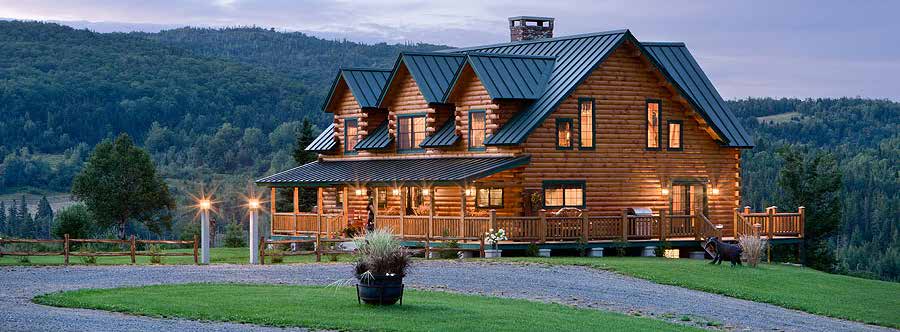 1. For an average-size home (2,500 square feet) with nice amenities, what's a realistic timeframe for building a custom log home? Six months from ground breaking to completion is a minimum time frame for most custom log homes. Of course, it also can take up to a year or more if you want more elaborate finishes, build a McMansion in a challenging location (say, on top of a difficult-to-reach mountain) or choose a more complicated log system. Of course, you should never include pre-construction activities (design, obtaining permits, etc.) in your actual construction timeline. Begin with approval of the building permit and work from there. If you can complete preliminary activities such as site clearing before the permit is issued, you'll be ahead of schedule.
1. For an average-size home (2,500 square feet) with nice amenities, what's a realistic timeframe for building a custom log home? Six months from ground breaking to completion is a minimum time frame for most custom log homes. Of course, it also can take up to a year or more if you want more elaborate finishes, build a McMansion in a challenging location (say, on top of a difficult-to-reach mountain) or choose a more complicated log system. Of course, you should never include pre-construction activities (design, obtaining permits, etc.) in your actual construction timeline. Begin with approval of the building permit and work from there. If you can complete preliminary activities such as site clearing before the permit is issued, you'll be ahead of schedule.
2. How do I prevent my contractor from going off schedule? Thoroughly research potential general contractors (G.C.s) before hiring anyone. Ask for references and check each one. Ask the contractor's previous clients how closely he stayed to the schedule and how he handled delays. Some construction delays are unavoidable (think snow storms in October), but good contractors have a "Plan B" to avoid many of them. These include alternate suppliers and subcontractors ("subs") in cases where the primary sources are delayed or unavailable. Another step is to include a penalty clause in the construction agreement that provides compensation if the project isn't completed in a certain amount of time. Depending on the home's size, this can be a penalty of hundreds or thousand dollars per month for each month the project is delayed. Six to 12 months is a realistic timeframe for most custom home projects, although there are many factors that can cause a project to take longer. Most penalty clauses include exceptions to protect the contractor against factors he can't control, so be prudent when exercising a penalty clause to be sure it's justified.
3. What should a construction schedule actually look like? A construction schedule should have start time and duration of each activity. In addition, it's good to allow for additional time to cover delays due to weather, schedule conflict with subcontractors or supplier delays. One good tool is called a Gantt Chart. Activities are listed in sequence down the left side of the chart and dates from beginning to end are listed across the top. The time required for each activity is shown as a horizontal bar on the appropriate line at the proper date and location. If you're using a general contractor, the schedule may show only site preparation, foundation work, completion of a dried-in shell, completion of mechanical rough-ins and finish work. If you'll serve as your home's GC, your schedule will have to include a lot more. Under the heading "foundation," for example, you may have included: excavation, forming or excavating footings, pouring footings, forming and pouring foundation walls, installing drain tile and insulation, waterproofing, backfilling and termite pre-treatment. If you're using a full-service foundation subcontractor, you may be able to abbreviate this list to show only excavation, foundation walls, backfilling, basement slab and termite treatment, since the other tasks will be included with the foundation wall task by your subcontractor.
4. When it comes to building materials other than my log home package, is it better for my general contractor builder to order them months in advance or wait? General contractors (G.C.s) Builders typically have several suppliers with whom they work regularly. They have a good idea of the lead times required to get items to your home site, and they'll take this into account when scheduling. Bottom line: I wouldn't recommend that your builder or materials too far in advance. First, storage space is at a premium, so most builders can't afford to stockpile materials that will sit around collecting dust for several months. Also, your builder will be invoiced for any materials as soon as they're delivered. Taking delivery on items well before they can be billed out to a client is something builders generally don't do, because it amounts to an interest-free loan! However, an alert builder might hear of a good deal on something needed for your project—say, an awesome kitchen sink—and ask you whether you want to purchase it. Then the builder might offer to store the piece if you're willing to pay for it. If you find a good deal on an item, talk to your builder about how to handle shipping, delivery and storage. Heavy items or large quantities may require a forklift or several strong arms, so don't let delivery come as a surprise. Hard-to-find items or anything that requires acclimation time should be ordered far enough in advance to allow for shipping delays or schedule changes. Hardwood flooring, for example should be allowed to acclimate for at least a week before being installed. But beware; You don't want to order flooring so far in advance that it gets in the way of construction activities or has to be handled several times before it gets used. Some items are included in your contractor's big, but their cost isn't specified. For example, your contract may include a $5,000 lighting allowance. If you come across a good lighting sale, buy the lights out of pocket and store them yourself. When the time comes, you can turn over the fixtures to your builder to install. Since you've already paid for them, they won't count toward your lighting allowance.
5. I have an oddly shaped lot that slopes dramatically. Any excavation hurdles I should know about? Sloping lots make spectacular house sites, but they also present challenges to excavators and builders because they require special equipment. Also, drainage from the excavation needs to be well planned to avoid washing out the excavation or creating severe erosion. Have your surveyor include topography in his site plan. This will allow your contractor to see the impact of the slope before construction starts. Sometimes a minor adjustment in the location of the house can make a great difference in the difficulty and cost of excavating and installing a foundation. Finally, don't ignore access to your home as you play with its location. After all, you need to get cars in and out of the home site!
5 Essential Log-Home Building Tips From a Pro
Veteran log-home builder Jim Cooper passes along 5 pearls of wisdom every new homeowner should know.











